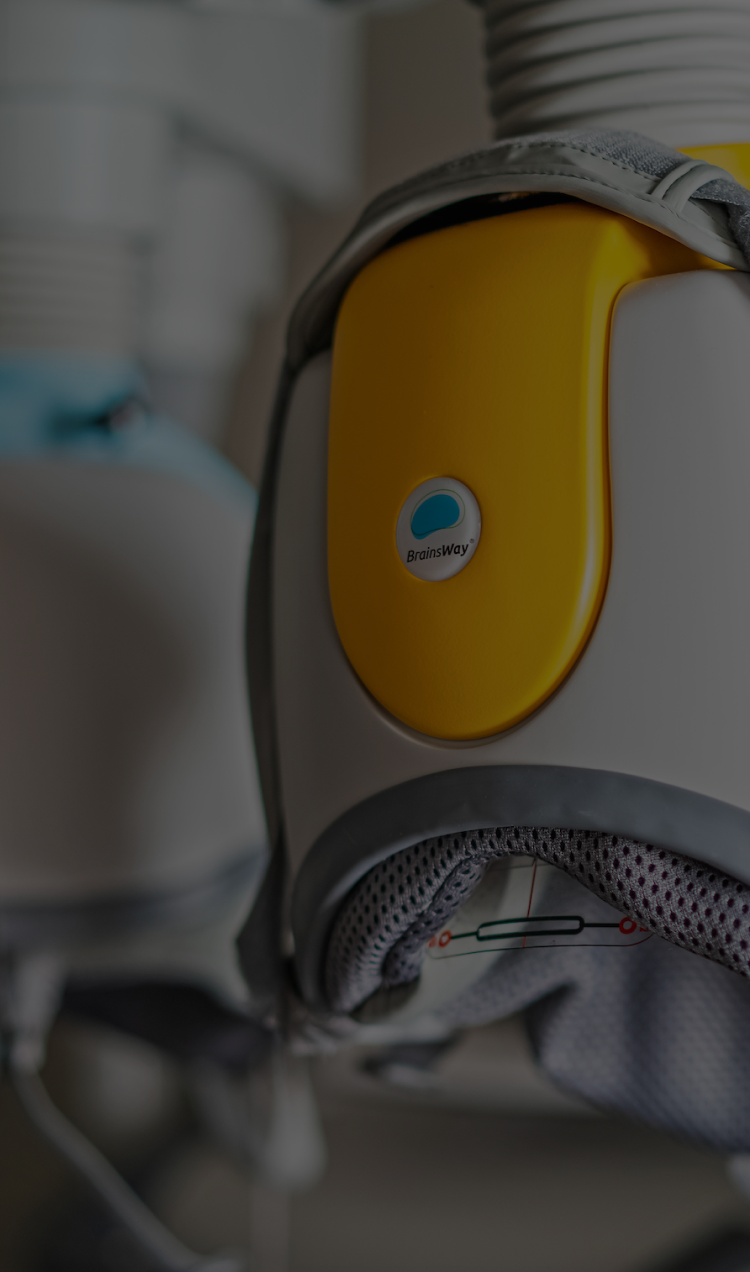Obsessive-compulsive disorder (OCD) is a chronic mental health condition characterized by a cycle of obsessive thoughts and compulsions1. OCD can be psychologically distressing, manifesting in uncomfortable and intrusive thoughts and repetitive behaviors that ease anxious feelings.
For individuals with OCD, obsessive thoughts and repetitive behaviors can interfere with daily life. OCD can take a significant toll on individuals with OCD and their family, friends, and colleagues. According to the National Institute of Mental Health, anxiety disorders are the most common mental health condition2 in the United States. However, less than 10% of those with OCD seek mental health treatment.
Treatment allows individuals with OCD to effectively manage their symptoms and live a fulfilling life. Deep transcranial magnetic stimulation (TMS), a safe and effective solution to treat OCD3, uses a non-invasive procedure to stimulate the brain structures associated with obsessive-compulsive disorder.
Symptoms of OCD
The symptoms of obsessive-compulsive disorder involve two components: ruminative thoughts (“obsessions”) and the behaviors meant to soothe them (“compulsions”).
Obsessions
Obsessions are recurring thoughts4, mental images, feelings, or urges that feel distressing and intrusive.
While individuals without OCD can dismiss these thoughts without experiencing anxiety or discomfort, those with OCD cannot. As a result, intrusive thoughts can interfere with the daily life of individuals with OCD. Although obsessions and their severity vary from person to person, common obsessions that fuel OCD-related anxiety include:
- Cleanliness and fear of contamination.
- Scrupulosity, i.e., recurring thoughts about mortality or blasphemy.
- Worrying about disastrous events or losing control.
- Focusing on counting, organizing, or perfectionist thinking.
- Taboo thoughts or mental rituals, i.e., thoughts about harming oneself or others.
Compulsions
Compulsions are repetitive behaviors or mental acts5 performed to soothe the anxiety and comfort associated with obsessions. Individuals suffering from OCD may associate the compulsion with relief feelings, making it difficult to stop or resist compulsive behaviors.
Compulsions may help to reduce anxiety. However, over time, ritualistic behaviors become a part of the individual’s OCD patterns and begin to induce stress. This creates a distressing cycle of thoughts and actions, causing despair and making it difficult to function in everyday life. Common compulsions include:
- Repetitive picking at blemishes, hangnails, scabs, etc.
- Excessive cleaning, showering, or handwashing.
- Ruminating on events to ensure nothing disastrous has happened.
- Repetitive behaviors, i.e., locking the door multiple times before leaving the house.
- Self-damaging behaviors, i.e., obsessively and repeatedly hitting oneself.
How is OCD diagnosed?
Under the fifth edition of the Statistical Manual of Mental Disorders (DSM-5), an individual must experience recurring, irrational thoughts or mental images and engage in behaviors to relieve anxiety.
To meet the criteria outlined by the DSM-56, obsessions and compulsions must not result from related mental health conditions. For example, an individual may engage in food rituals related to eating disorders, repetitive behaviors related to tic disorders, or phobias related to panic disorder.
It’s important to keep in mind that not all repetitive behaviors are indications of OCD, and the diagnosis of OCD primarily depends on the function of the behavior. If repetitive behaviors or mental rituals reduce anxiety, they are considered compulsions under the DSM-5 diagnostic criteria.
In children and adolescents, adults often attribute OCD symptoms to inattention, acting out, or withdrawing. Because the symptoms of OCD can manifest differently in children, adolescents, and adults, it’s important to seek a diagnosis from a licensed mental health professional if you think you have OCD.
TMS for OCD
Individuals with obsessive-compulsive disorder who pursue treatment often experience an improved quality of life and improved functioning. A comprehensive treatment plan for OCD can effectively improve an individual’s ability to function at school and work, develop and maintain interpersonal relationships, and enjoy leisure activities.
In most cases, OCD treatment will include cognitive therapy, exposure and prevention therapy, and medication as first-line treatments. If these options do not produce satisfactory results, deep transcranial magnetic stimulation can help individuals safely and effectively manage their OCD symptoms.
Deep Transcranial Magnetic Stimulation
Deep TMS is a new treatment approach that could help individuals with OCD, especially those who have not experienced medication or therapy improvement. Deep TMS, the only FDA-approved non-invasive treatment7 for obsessive-compulsive disorder, is an innovative mental health treatment that regulates the brain’s activity using deep and direct magnetic pulse to stimulate the brain structures related to OCD.
Deep TMS is a type of transcranial magnetic stimulation, which has been used to treat major depression since 2008. Individuals with OCD can safely use deep TMS combined with other forms of therapy8, including cognitive therapy and exposure and response prevention therapy.
Additionally, deep TMS is not associated with any adverse side effects. Because TMS offers a non-invasive treatment option, clients can easily incorporate TMS treatment into their daily schedule.
How does Deep TMS work?
At All Points North Lodge, we take great precautions to ensure that you feel comfortable and safe during your treatment. You’ll begin each session by checking in with your mental health care provider, and we’ll give you a pair of earplugs to use during the procedure.
During each TMS session, you’ll sit with a cushioned helmet on your head. The helmet uses magnetic fields to stimulate the brain’s areas associated with obsessive-compulsive disorder and improve your symptoms. The procedure will sound like repetitive clicking or tapping coming from within the helmet.
BrainsWay’s Deep TMS treatment9 requires daily sessions, which average approximately 20 minutes, for four to six weeks. As the procedure is non-invasive, most clients do not experience any discomfort, with a minority of clients reporting a headache after the first few sessions. Deep TMS does not require hospitalization, meaning you’ll be able to return to your day as normal after each session without worrying about any downtime.
Is Deep TMS effective in treating OCD?
In a 2019 multicenter study10 published by the American Journal of Psychiatry, researchers found that focusing brain stimulation on “the medial prefrontal cortex and anterior cingulate cortex significantly improved OCD symptoms,” confirming the efficacy of deep TMS.
The study showed that after six weeks of treatment, the treatment group experienced improved symptoms compared to the control group. Researchers also found that the treatment group experienced symptom improvement for at least one month following the end of deep TMS treatment.
The study’s primary method to measure symptom improvement was the Yale-Brown Obsessive-Compulsive Scale (Y-BOCS)11, the gold standard measure of OCD symptom severity. Using the Y-BOCS, researchers found that 38.1% of patients in the treatment group achieved a full response reduction in symptom severity, compared to 11.1% in the control group. Also, over half (54.8%) of patients in the treatment group experienced a partial response of reduction in symptom severity, compared to 26.7% in the control group.
In a 2020 post-marketing study of over 200 patients12, deep TMS showed significant effects in a real-life clinical practice setting. The study revealed that nearly 60% of OCD patients experienced reduced symptoms, with 70% of patients experiencing improvement after an average of 18.5 sessions. Meanwhile, over 50% of patients experienced sustained symptom improvement after an average of 20 sessions.
Is Deep TMS safe?
As a non-invasive treatment option for obsessive-compulsive disorder, deep TMS does not require anesthesia and is not linked to any significant side effects. At All Points North Lodge, we use the only FDA-approved deep TMS treatment device, the BrainsWay H7-coil, to directly target the anterior cingulate cortex.
In a 2018 study published by the Brain Stimulation Journal, researchers highlighted the safety of Deep TMS treatment13, finding it to be a “safe and effective intervention for improving OCD symptoms in patients who failed to receive sufficient benefits from treatments with SRIs and CBT.”
Deep TMS at All Points North Lodge
If you haven’t noticed an improvement with SRIs or haven’t seen satisfactory results with medication or therapy, deep transcranial magnetic stimulation offers a safe, effective, and non-invasive treatment option to help you improve your OCD symptoms.
If you’re interested in learning more about deep TMS, our experienced team at All Points North Lodge can determine whether you are a good candidate for deep TMS treatment and help you explore your treatment options to improve your quality of life and manage your symptoms effectively. Contact us today for a free consultation.
Reference
- Clark, David A. & Radomsky, Adam S. (2014). Introduction: A global perspective on unwanted intrusive thoughts. Journal of Obsessive-Compulsive and Related Disorders. Available online 18 February 2014. DOI: 10.1016/j.jocrd.2014.02.001 http://www.sciencedirect.com/science/article/pii/S2211364914000128
- Mushkin, Philip. “Anxiety Disorders.” What Are Anxiety Disorders?, The American Psychiatric Association, June 2021, www.psychiatry.org/patients-families/anxiety-disorders/what-are-anxiety-disorders#:~:text=Anxiety%20disorders%20are%20the%20most,of%20effective%20treatments%20are%20available.
- Kuntz, Leah. “Deep Transcranial Magnetic Stimulation: A New Solution to Obsessive-Compulsive Disorder.” Psychiatric Times, Psychiatric Times, 16 Nov. 2020, www.psychiatrictimes.com/view/deep-transcranial-magnetic-stimulation-a-new-solution-to-obsessive-compulsive-disorder.
- Clark, David A., and Adam S. Radomsky. “Introduction: A Global Perspective on Unwanted Intrusive Thoughts.” Journal of Obsessive-Compulsive and Related Disorders, Elsevier, 18 Feb. 2014, www.sciencedirect.com/science/article/abs/pii/S2211364914000128.
- Colon-Rivera, Hector, and Molly Howland. “What Is Obsessive-Compulsive Disorder?” Obsessive-Compulsive Disorder, The American Psychiatric Association , Dec. 2020, www.psychiatry.org/patients-families/ocd/what-is-obsessive-compulsive-disorder.
- Substance Abuse and Mental Health Services Administration. Impact of the DSM-IV to DSM-5 Changes on the National Survey on Drug Use and Health [Internet]. Rockville (MD): Substance Abuse and Mental Health Services Administration (US); 2016 Jun. Table 3.13, DSM-IV to DSM-5 Obsessive-Compulsive Disorder Comparison. Available from: https://www.ncbi.nlm.nih.gov/books/NBK519704/table/ch3.t13/
- Caccomo, Stephanie. “FDA Permits Marketing of Transcranial Magnetic Stimulation for Treatment of Obsessive Compulsive Disorder.” U.S. Food and Drug Administration, FDA, 17 Aug. 2018, www.fda.gov/news-events/press-announcements/fda-permits-marketing-transcranial-magnetic-stimulation-treatment-obsessive-compulsive-disorder#:~:text=FDA%20permits%20marketing%20of%20transcranial%20magnetic%20stimulation%20for%20treatment%20of%20obsessive%20compulsive%20disorder,-Share&text=Today%2C%20the%20U.S.%20Food%20and,obsessive%20compulsive%20disorder%20(OCD).
- Vidrine, Stephen. Understanding Deep Transcranial Magnetic Stimulation For OCD, NAMI, 8 Nov. 2019, www.nami.org/Blogs/NAMI-Blog/November-2019/Understanding-Deep-Transcranial-Magnetic-Stimulation-For-OCD.
- BrainsWay. “What Happens during a Deep TMS Procedure?” Patient FAQ, BrainsWay, 10 Feb. 2021, www.brainsway.com/patients-faqs/what-happens-during-a-deep-tms-procedure/.
- Carmi, Lior et al. “Efficacy and Safety of Deep Transcranial Magnetic Stimulation for Obsessive-Compulsive Disorder: A Prospective Multicenter Randomized Double-Blind Placebo-Controlled Trial.” The American journal of psychiatry vol. 176,11 (2019): 931-938. doi:10.1176/appi.ajp.2019.18101180
- Goodman WK, Price LH, Rasmussen SA, et al. The Yale-Brown Obsessive Compulsive Scale: II. Validity. Arch Gen Psychiatry. 1989;46(11):1012–1016. doi:10.1001/archpsyc.1989.01810110054008
- Roth, Yiftach et al. “Real-world efficacy of deep TMS for obsessive-compulsive disorder: Post-marketing data collected from twenty-two clinical sites.” Journal of psychiatric research vol. 137 (2021): 667-672. doi:10.1016/j.jpsychires.2020.11.009
- Carmi, Lior et al. “Clinical and electrophysiological outcomes of deep TMS over the medial prefrontal and anterior cingulate cortices in OCD patients.” Brain stimulation vol. 11,1 (2018): 158-165. doi:10.1016/j.brs.2017.09.004



